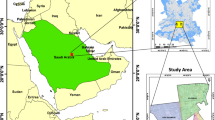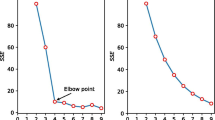Abstract
This paper proposes a new neuro-fuzzy technique suitable for binarisation or, in general, the colour reduction of digital documents. The proposed approach uses the image colour values and additional local spatial features extracted in the neighbourhood of the pixels. Both image and local features values feed a Kohonen self-organised feature map (SOFM) neural network classifier. After training, the neurons of the output competition layer of the SOFM define a first approach of the final classes. Using the content of these classes, fuzzy membership functions are obtained that are next used by the fuzzy C-means (FCM) algorithm in order to obtain the colours of the final document. The method can be applied to greyscale and colour documents; it is suitable for improving blurring and badly illuminated documents and can be easily modified to accommodate any type of spatial characteristics.











Similar content being viewed by others
References
Kittler J, lllingworth J (1986) Minimum error thresholding. Patt Recog 19:41–47
Reddi SS, Rudin SF and Keshavan HR (1984) An optimal multiple threshold scheme for image segmentation. IEEE Tran Sys Man Cybern 14(4):661–665
Otsu N (1979) A threshold selection method from grey level histograms. IEEE Tran Sys Man Cybern 9(1):62–69
Kapur JN, Sahoo PK and Wong AK (1985) A new method for grey level picture thresholding using the entropy of the histogram. Comp Vis Graph Imag Process 29:273–285
Papamarkos N, Gatos B (1994) A new approach for multithreshold selection. Comp Vis Graph Imag Process Graph Mod Imag Proc 56(5):357–370
Sahoo PK, Soltani S and Wong AKC (1988) A survey of thresholding techniques. Comp Vis Graph Imag Process 41:233–260
Strouthopoulos C, Papamarkos N (2000) Multithresholding of mixed type documents. Engin App Art Intellig 13(3):323–343
Strouthopoulos C, Papamarkos N (1998) Text identification for image analysis using a neural network. Imag Vis Comp 16:879–896
Kohonen T (1997) Self-organizing maps. Springer, Berlin Heidelberg New York
Haykin S (1994) Neural networks: a comprehensive foundation. MacMillan, New York
Yang Y, Yan H (2000) An adaptive logical method for binarization of degraded document images. Patt Recog 33(5):787–807
O’Gorman L (1994) Binarization and multithresholding of document images using connectivity. CVGIP: Grap Mod Imag Proc 56(6):494–506
Parker JR (1991) Gray level thresholding in badly illuminated images. IEEE Trans Patt Anal Mach Intell 13(8):813-819
Sauvola J, Pietikäinen M (2000) Adaptive document image binarization. Patt Recog 33(2):225–236
Trier OD, Taxt T (1995) Improvement of integrated function algorithm for binarization of document images. Patt Recog Lett 16(3):277–283
Liu Y, Srihari SN (1997) Document image binarization based on texture features. IEEE Trans Pattern Anal Mach Intell 19(5):540–544
Nauck D, Klawonn F and Kruse R (1997) Neuro-fuzzy systems. Wiley, New York
Chi Z, Yan H and Pham T (1996) Fuzzy algorithms: with applications to image processing and pattern recognition. World Scientific, Singapore
Sagan H (1994) Space-filling curves. Springer, Berlin Heidelberg New York
Chung KL, Tsai YH and Hu FC (2000)Space-filling approach for fast window query on compressed images. IEEE Tran Imag Proc 9(12):2109–2116
Papamarkos N, Atsalakis A (2000) Grey level reduction using local spatial features. Comp Vis Imag Under 78:336–350
Huang LK, Wang MJ (1995) Image thresholding by minimizing the measure of fuzziness. Patt Recog 28:41–51
Papamarkos N, Strouthopoulos C and Andreadis I (2000) Multithresholding of color and grey level images through a neural network technique. Imag Vis Comp 18:213–222
Duda RO, Hart PE (1973) Pattern recognition and scene analysis. Wiley, New York
Heckbert P (1982) Color image quantization for frame buffer display. Comp Graph 16:297–307
Wan SJ, Prusinkiewicz P and Wong SKM (1990) Variance based color image quantization for frame buffer display. Col Res Appl 15(1):52–58
Dekker AH (1994) Kohonen neural networks for optimal colour quantization. Ntwk: Comp Neur Sys 5:351–367
Author information
Authors and Affiliations
Corresponding author
Rights and permissions
About this article
Cite this article
Papamarkos, N. A neuro-fuzzy technique for document binarisation. Neural Comput & Applic 12, 190–199 (2003). https://doi.org/10.1007/s00521-003-0382-z
Received:
Accepted:
Published:
Issue Date:
DOI: https://doi.org/10.1007/s00521-003-0382-z




